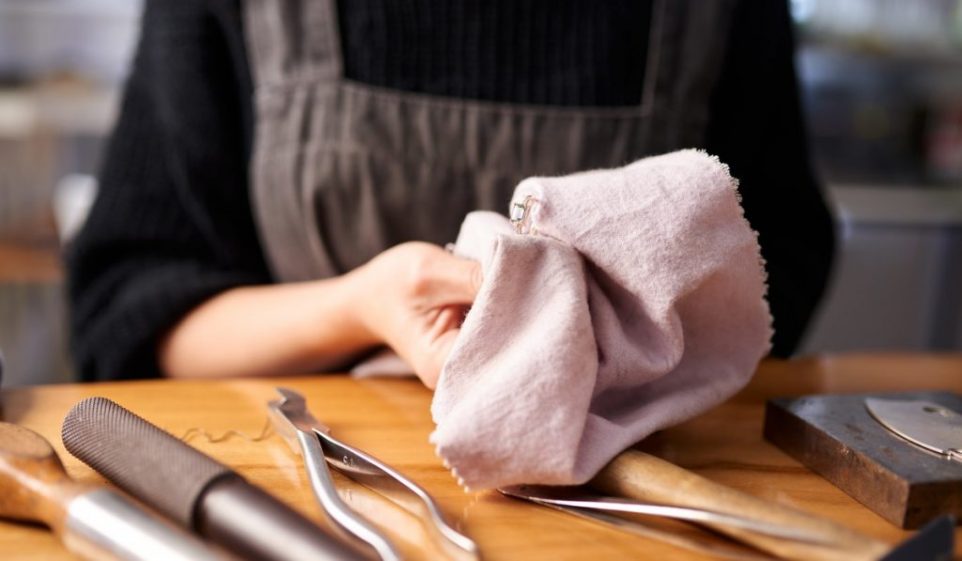How to Clean Jewelry to Make It Look Like New Again

Identifying Jewelry Type
Before starting, identify the type of jewelry you’re working with. Natural stones and metals are often plated with other materials for decorative purposes, so understand the makeup of a piece before cleaning. If you assembled the jewelry yourself, check the jewelry-making kit for information on the type of stone and metals used.
Natural gemstones are mined from the earth and should be handled with care as they can become chipped or broken with rough handling. On the other hand, synthetic stones have gone through an elaborate process of being grown in a laboratory and are generally more resilient than their natural counterparts.
Another big factor when dealing with jewelry is the metal used in its construction. Most metal jewelry is either solid or plated. Solid metal jewelry is made out of just one metal, such as gold, silver, or bronze. Plated metal jewelry is coated with a thin layer of another metal. Plated jewelry is typically more delicate than solid metal and requires different cleaning methods than solid metals would require.
Tools Needed for Cleaning
View this post on Instagram
Now that we’ve identified the different parts of our jewelry, it’s time to gather all the supplies needed for successful cleaning. You don’t necessarily need an expensive or elaborate set-up, as basic items from around the house should suffice. Here are the must-have tools for any jewelry-cleaning journey:
- A soft bristle brush: Helps remove dirt and debris on your jewelry. Use a brush specific for cleaning jewelry, as generic ones may be too harsh and damage delicate pieces.
- Cotton swabs are great for getting into small crevices and wiping away gunk that a brush can’t reach.
- Liquid jewelry cleaner: Strongly recommended for stubborn dirt and grime. I prefer this over home remedies or general household cleaners. You can purchase a dedicated cleaner for jewelry from most craft stores and online retailers or make your solution by combining warm water, baking soda, and dish soap in a bowl. Be sure to thoroughly rinse off any cleaner before putting on the piece once you’re done.
- A soft cloth: Flannel or microfiber cloth should be used to polish the piece after it has been washed and dried to preserve its sparkle and shine
Cleaning Natural Jewelry
Natural gems need special attention when it comes to proper cleaning since they are more prone to damage from improper treatment than synthetic gems are. It’s always best to consult professional jewelers when cleaning valuable pieces, but here are some simple tips.
Soft Stones
Opal, turquoise, or amber are softer stones that should not be treated with chemical cleaners. Use warm water and mild detergent such as dish soap. Before submerging your stone in the water, use a soft-bristled brush to remove any surface dirt or grime that may inhibit successful cleaning. Once submerged in the soapy solution, let it sit for 15 minutes before removing and rinsing off the excess soap.
Diamonds
Diamonds are often easier to clean than softer stones since they’re harder materials, but there are still certain techniques you should follow:
- First, ensure all dirt is removed before attempting any chemical cleaner. Use warm water alongside a soft-bristled toothbrush for these tasks.
- After confirming that the diamond is free from any dirt particles, the next step is to prepare an ammonia-based cleaning solution as directed by the product instructions. Typically, these solutions involve mixing rubbing alcohol or white vinegar with water. Immerse the diamond in the solution for a maximum of 20 minutes, depending on how severe the discoloration is.
- Rinse the diamond thoroughly with lukewarm water to remove any remaining residue.
Cleaning Synthetic and Plated Jewelry
As previously noted, certain jewelry pieces are plated with materials that require careful cleaning to avoid erosion of the outer layer, resulting in loss of color or shine. It’s best to avoid abrasive scrubbing of these areas during cleanings whenever possible. Be cautious when using at-home cleaning solutions. Boiling water can cause irreversible damage to plated pieces, depending on the material used. Opt for lukewarm water to prevent any potential damage.
Inspect it for any remaining dirt particles that may have been missed once the cleaning is complete. You can use a magnifying glass to help you see any hard-to-spot particles. Once you’re happy with the cleaning, use a soft cloth to polish it for maximum shine.
If you want to protect your piece from oxidation damage over time, you can apply a clear nail polish or resin sealant. This trick works exceptionally well for jewelry made of brass, comparable to results you’d expect from a brass polish. While this step isn’t always necessary, it can help extend the wearability of your piece in the long run.
Elevating the Shopping Game
Our platform offers in-depth reviews and analyses across various product categories, empowering you to shop with confidence and precision. Here, transparency and detailed research pave the way for smart choices that reflect your needs and values. Join our community and elevate your shopping experience from buyer to expert, one report at a time.